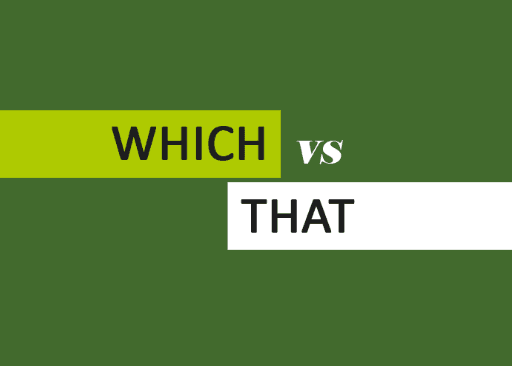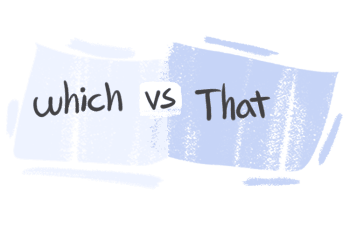Untangling Grammar Knots: A Guide to Using 'Which' and 'That'
Contents

Imagine yourself in a critical business meeting, presenting to foreign delegates. You're smoothly sailing through until you stumble over a sentence where you're unsure whether to use 'which' or 'that'. You see puzzled faces, and it dawns on you - your confusion between 'which' vs 'that' has made you pause too long in the middle of a sentence.
This situation is all too common. As non-native English speakers, we often struggle to differentiate between these two relative pronouns and use them accurately.
In this blog post, we'll delve into the nuances of which vs that usage, providing thorough explanations, real-world examples, interactive exercises, and more. So buckle up for this enlightening journey towards mastering the usage of 'which' vs 'that'.
What's The Difference? Which vs That Meaning
The words 'which' and 'that' are both relative pronouns used in English but they serve different purposes. Here's a simple definition:
Which: Used in non-restrictive clauses, providing additional information that isn't essential to the sentence.
That: Used in restrictive clauses, providing necessary information to the sentence.
Let's compare them through this table:
Which | That | |
Use | Non-restrictive clauses | Restrictive clauses |
Information | Additional, not essential | Essential for understanding |
Now, let's look at some usage rules:
Use 'which' when the information it introduces is additional and can be left out without changing the meaning of the sentence.
Use 'that' when the information it introduces is crucial to understanding what is being talked about.
Always use commas before 'which'.
Never use commas before 'that'.
Where Do We Use Which vs That
In English language, the usage of which vs that relative pronouns can sometimes be confusing. But don't worry, with a little bit of practice and understanding, you’ll get the hang of it.
The word 'which' is often used in non-restrictive clauses. This is additional information which doesn't change the meaning of a sentence even if removed. For instance, consider this sentence: "My bike, which is red in colour, is parked outside." Here 'which is red in colour' is an extra detail about the bike but removing it doesn't change the essential information about my bike being parked outside.
On the other hand 'that' is used in restrictive clauses. These are vital pieces of information without which the meaning of a sentence changes. For example: "The book that I bought yesterday is very interesting." If we remove 'that I bought yesterday', we won't know which book is being referred to.
Exceptions in Which vs That Usage
Just like every language, English also has its fair share of exceptions. Even in the usage of which vs that, there are instances where both can be used interchangeably. Let's delve into those areas to gain a clearer understanding.
For example, consider the sentence - "The book which I borrowed from the library is interesting." Here, 'which' is used to introduce a non-restrictive clause.
However, 'that' can also be used instead of 'which' without altering the sentence meaning - "The book that I borrowed from the library is interesting".
This demonstrates how sometimes these relative pronouns can be used interchangeably without changing the sentence's meaning.
Practical Tips for Using Which vs That

Let's take a moment to untangle the which vs that conundrum. Follow these handy tips to grasp the usage of 'which' and 'that' effectively:
Use 'that' in restrictive clauses: A restrictive clause is essential to the meaning of a sentence, and hence it cannot be left out. For instance, "The movie that you recommended is amazing." Here, 'that you recommended' is a restrictive clause as it specifies which movie we're talking about.
Use 'which' in non-restrictive clauses: A non-restrictive clause can be removed from the sentence without changing its main meaning. It usually adds extra information and is separated by commas. For instance, "The book, which has a blue cover, is amazing." Here, 'which has a blue cover' merely provides additional information.
Remember this rule of thumb: THAT restricts, WHICH discloses!
For further understanding of the use of which vs that, test your knowledge with our quiz.
How Well Do I Understand These Rules? Which vs That Quiz
Let's put your 'which vs that' knowledge to the test with this quick quiz.
Fill in the blank: The book _______ you gave me was very interesting.
Choose the right word: My bike, ________ is blue, has a flat tire.
Select the correct option: She didn’t like the movie ________ we saw last night.
Now, check your answers:
That - We use 'that' when the information it introduces is necessary to understand which specific thing or person we are talking about.
Which - 'Which' is used when adding non-essential information to a sentence.
That - Again, 'that' is correct because it specifies a particular movie from many others.
Well done! If you found any of this challenging, don't worry – with consistent practice using exercises and worksheets you can master these nuances of the English language.
Key Takeaways
As we conclude, remember that the difference between 'which' and 'that' is more than just semantic - it's about clarity and precision. The rules of ‘which vs that’ usage are simple: use 'that' in restrictive clauses when the information is essential; use 'which' in nonrestrictive clauses when the details are additional.
Keep practising these principles in everyday conversations to improve your spoken English skills. Remember, learning a language takes constant practice and patience.
If you’re seeking further guidance on enhancing your English proficiency, Clapingo offers personalized one-on-one coaching sessions with native English speakers. These sessions focus on fluency, pronunciation, vocabulary and sentence structure - a comprehensive approach to mastering English communication!
FAQs
1. What is the main difference between 'which' and 'that'?
The main difference lies in their usage. 'That' introduces a restrictive clause, while 'which' introduces a non-restrictive or parenthetical clause.
2. Can 'which' and 'that' be used interchangeably?
No, they can't be used interchangeably. Misuse of 'which' and 'that' can lead to confusion in meaning. Understanding their proper usage is key.
3. Why is it important to distinguish between the use of 'which vs that'?
Understanding the correct use of which vs that is crucial for clear, concise communication, especially in professional settings where precision in language matters.
Comments
Your comment has been submitted successfully!